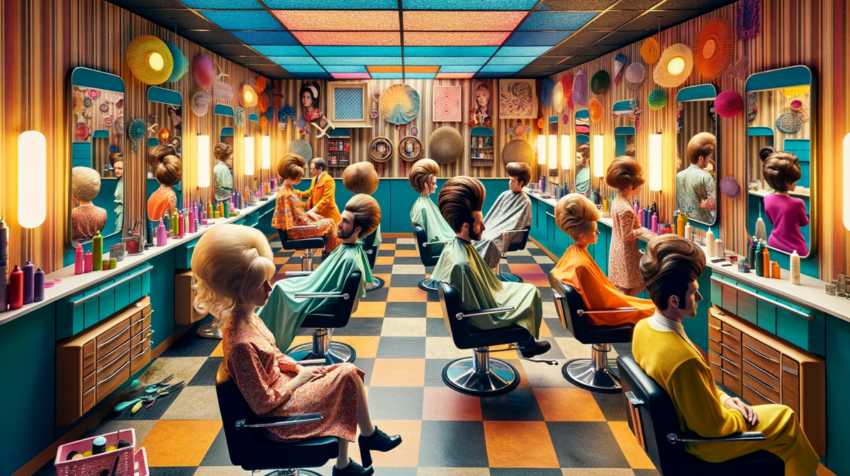Bouffants and Beehives: 1960s America's Hair Heights

Introduction to Gravity-Defying Hairdos
Let us embark on a journey back to the 1960s - a decade of bell-bottoms, free love, and, most importantly, hair so big it could be seen from outer space. I'm talking about bouffants and beehives, the hairstyles that defined a generation and made hairdressers very, very rich. The bouffant, a voluminous, teased creation, and the beehive, a gravity-defying masterpiece, were seen on the heads of stylish women across the nation. From glamorous movie stars to suburban housewives, these fancy follicular feats captured the spirit of the times and left a lasting impression on generations to come.The Origins of the Bouffant and the Beehive
Like all great things, the bouffant and the beehive had their origins in France. The bouffant, derived from the French word "bouffer" meaning "to puff out," was first seen on fashionable French ladies in the 18th century. But the bouffant as we know it today was popularized by legendary hairstylist and visionary, Raymond Bessone, who saw an opportunity to liberate women from the confines of tight curls and pin-straight tresses. The beehive, on the other hand, was the brainchild of Margaret Vinci Heldt, a Chicago-based hairdresser, who was inspired by a black velvet fez-like hat she had been given as a gift. The hat, she decided, would make the perfect mold for a new hairdo, and thus, the beehive was born.How to Achieve Maximum Hair Height: A Step-By-Step Guide
Now, my dear friends, let me share with you the secrets of creating the perfect bouffant and beehive, so you too can join the ranks of the hair elite. Warning: you may need an engineering degree to follow these complex instructions.1. Gather Your Tools
- Hairbrush
- Hairspray
- Hairpins
- Rat-tail comb (a comb with a long, narrow handle)
- Teasing comb (a comb designed for teasing hair)
- Patience
- Arm strength
2. Prepare Your Hair
For best results, begin with freshly washed and dried hair. If your hair is naturally curly, straighten it first with a flat iron - we want lift, not ringlets.3. Section Your Hair
Divide your hair into three sections - the crown, the sides, and the back. The crown section should be a horseshoe shape that extends from the end of one eyebrow to the other, while the sides should extend from the ears forward. Clip each section out of the way.4. Channel Your Inner Architect
Beginning with the crown section, take small subsections of hair, and backcomb (or tease) them with your teasing comb. Spray each teased subsection with hairspray to ensure it stays put. The goal here is to create a solid base of hair at the scalp that will support the rest of the style. Repeat this process with the side sections, angling the hair upwards and away from the face.5. Smooth It Out
Once you have successfully teased your hair into a cotton candy-like cloud, use your rat-tail comb to gently smooth the outer layer of hair over the teased sections. Be careful not to disturb the teasing - you don't want to deflate your hard work. For the bouffant, gather the smoothed hair at the back of your head, and secure it with a hairpin or two. If you're going for the beehive, continue smoothing and shaping the hair upwards into its iconic conical shape, using hairpins as needed.6. Secure Your Masterpiece
Finally, liberally douse your head in hairspray, making sure to hold your breath - there's no need to give yourself a hairspray high. Congratulations, you have now achieved ultimate hair height!The Legacy of the Bouffant and the Beehive
While the popularity of the bouffant and the beehive may have waned since their heyday in the '60s, these hairstyles continue to inspire awe and admiration. Modern-day stars like Adele and Amy Winehouse have paid homage to the beehive, while the bouffant has made a resurgence on the red carpet. So next time you're feeling adventurous, why not try your hand at crafting one of these iconic 'dos? After all, you never know when you might need to smuggle a small animal or store secret documents in your hair.Article kindly provided by foreverinfashion.org
Latest Articles
- The Psychology of Tattoo Aesthetics: Why Certain Imagery Resonates
- Style That Works With Your Body, Not Against It
- Fashion Tourism on Wheels: Curated Shopping Routes Led by Chauffeur Guides
- The Charm of Certainty in a World of Indecision
- Can an Everyday T-Shirt Be Turned into a Modern Heirloom?
- Color, Ceremony, and the Psychology of Celebration
- Styling Graphic T-Shirts for Different Body Types
- Getting Kids to Wear Their Hats Without a Bribe or a Meltdown
- Mastering the Art of Being the Unnoticed Photographer
- Quiet Sportswear Moves Loudly
- Fashion's Most Misunderstood Color Is Brown
- Weight Matters When Cotton Gets Real
- SKU's Out for Summer: Why Your Warehouse Is Melting Down
- Ink as Accessory - How Tattoos Are Replacing Jewelry in Modern Style
- Accessories
- Jewellery
- Footwear
- Skirts and Dresses
- Shirts and Blouses
- Beauty and Makeup
- Fashion Photography
- Sustainable Fashion
- Street Style
- Fashion History
- Fashion Business
- Fashion Styling
- Fashion Events
- Plus-Size Fashion
- Men's Fashion
- Women's Fashion
- Fashion Blogging
- Fashion Trends
- Fashion Retailers
- Fashion Tips and Advice
- Fashion Business Startups
- Fashion Around the World
- Lingerie
- Sportswear
- Weddings

